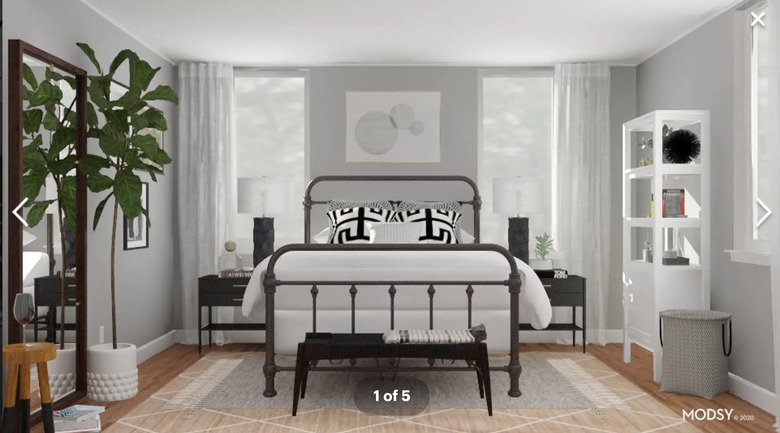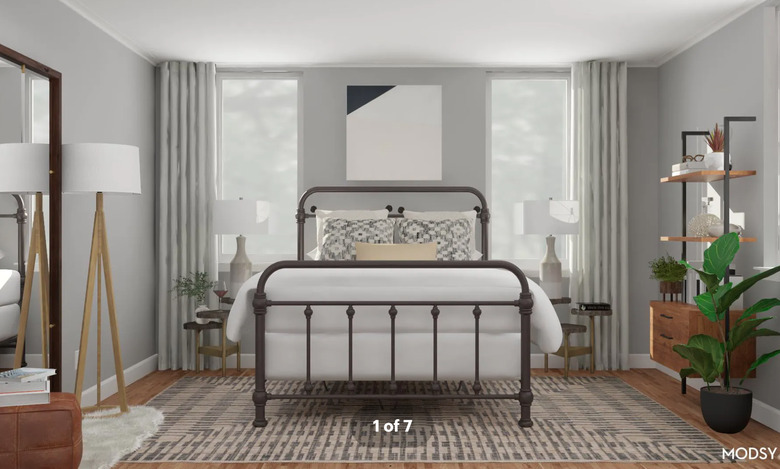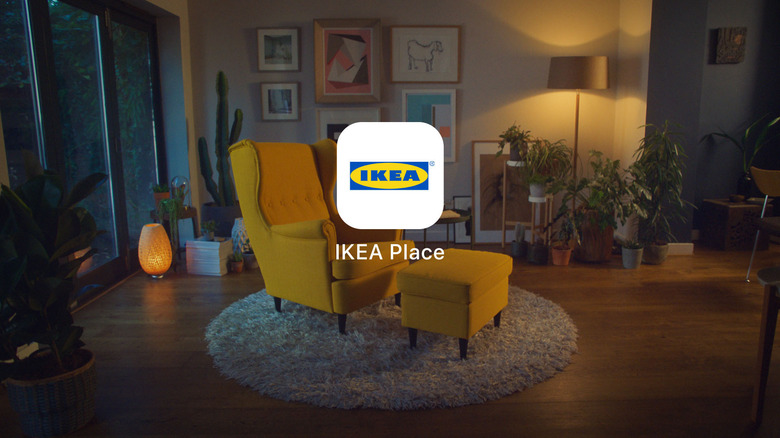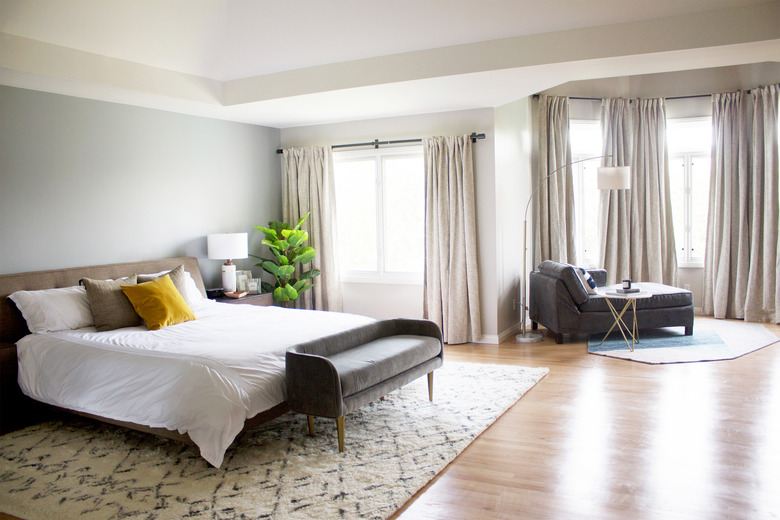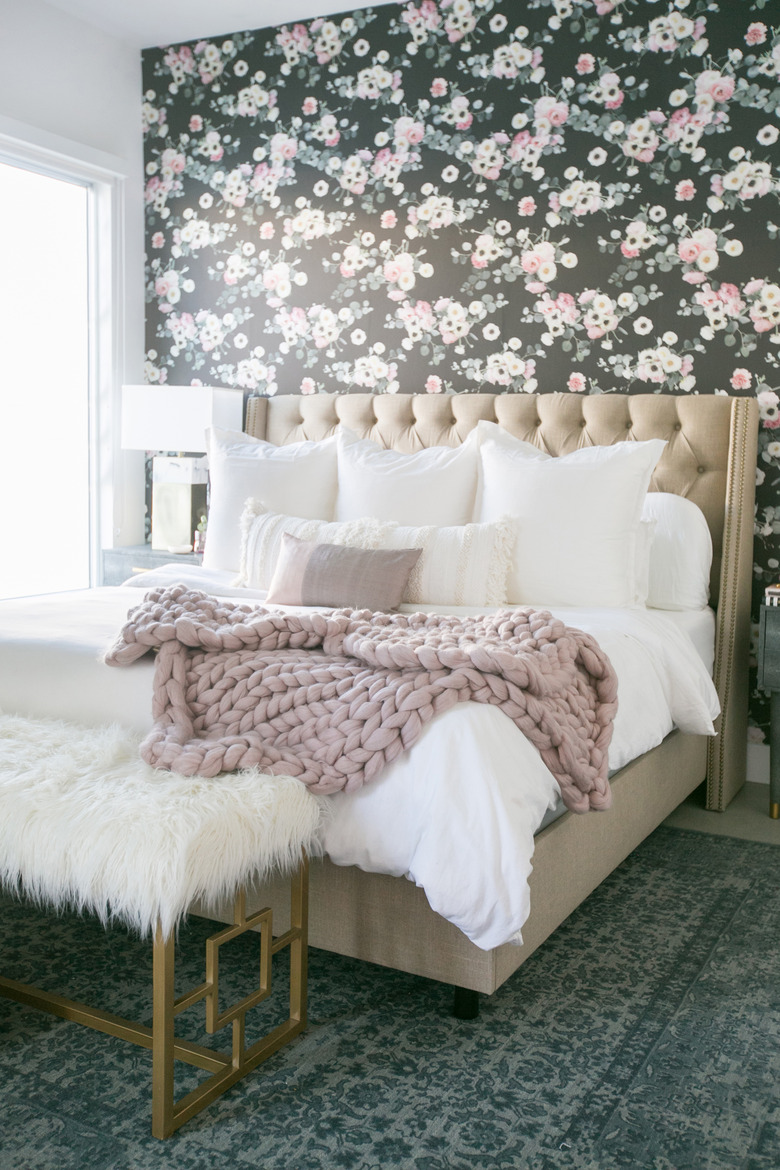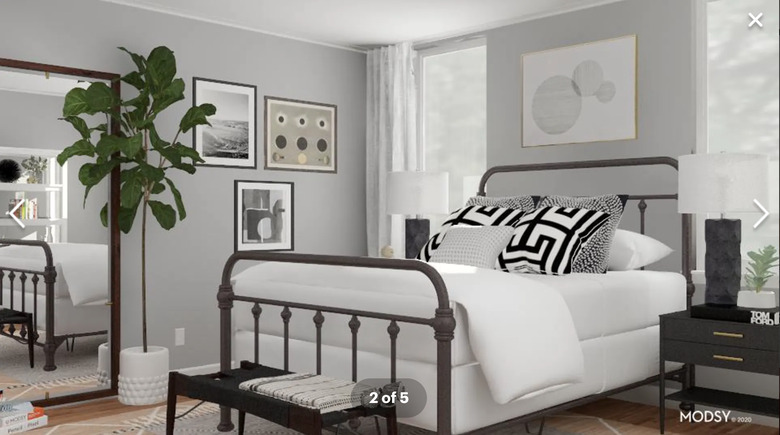I Tried 4 Virtual Home Design Services For My Bedroom Makeover — Here's What Happened
I'll be the first to admit — as someone with a well-established sense of style (case in point: you're reading this right now) and a personality that skews toward, shall we say, "opinionated" — I wasn't 100% sure what a virtual design service could offer someone like me. Surely I'd have just as much luck scouting furnishing finds from any of the industry's tentpole brands on my own, I thought, and I wouldn't have to embark on the somewhat awkward endeavor of explaining my tough-to-pin-down personal style to someone else. (Cue: "my special eyes!" melodrama.) As a full-time freelancer I'm well accustomed to the whims of clients, and as such I know that an "I'll know it when I see it" client is pretty much the worst thing one can be tasked with; it seemed particularly unfair to pin that on someone else.
But in learning about four different "virtual interior design" services on the market, I made some surprising discoveries: One, maybe my very-particular aesthetic isn't as uncommon (or difficult to communicate) as I thought, and two, that even a dyed-in-the-wool design nerd can use a little guidance from the pros every once in a while. Here's how it all went down.
The challenge:
The challenge:
While the guest-facing areas of my house (kitchen, living room, bathroom) are coming together quite nicely since I moved into my current home a little under two years ago, my bedroom has fallen victim to something that I think is pretty common among storage-limited apartment dwellers of a certain age: It's basically become a dumping ground for all the non-pretty things that I need to interact with in my daily life. Hand-me-down furniture pieces, Rubbermaid bins that don't fit anywhere else, random paperwork I haven't gotten around to dealing with yet — it's all there (and more!).
Because it's not an area that's used for entertaining, it's been allowed to be kind of a mess. Until now, that is.
My main goals: Upgrade my bedroom to show off my personal style akin to the rest of the house (it's pretty generic at the moment) and make it super-functional for storing all that stuff that can't live anywhere else, while also dialing up the zen vibes (unsurprisingly, staring at a bunch of junk isn't exactly restful at the end of a long day). Oh, and my budget is pretty much nonexistent. Easy, right?
Best for first-timers: Modsy
Best for first-timers: Modsy
My skepticism for virtual design services being well-documented, I have to say: Modsy is the platform that totally blew my cold cynical heart away. Modsy VP of Style Alessandra Wood told me that Modsy prides itself on giving users "an incredibly lifelike and perfectly scaled 3D model of their home," and I honestly think she was underselling it. The virtual mock-ups I received were pretty striking — they were recognizable as my bedroom in every way, but soooooo much better.
But before I get ahead of myself, what made Modsy stand out from the start was ease of use. While several of the virtual design services required users to complete questionnaires to kick off the process (a very understandable starting point), Modsy limited the number of inspiration photos you could choose. At first, this worried me — I have SPECIAL style, remember???? — but services with a seemingly endless scroll of Pinterest photos to choose from actually made me less and less sure of what I liked for myself, as opposed to just what I recognized as a well-styled environment. (Questioning everything about the core of your very being: not a fun part of the design process.) And when the final designs came back, it was clear to me that my Modsy designer had distilled my overall vibe in visible, actionable ways.
Speaking of "final design" — most services account for some amount of mind-changing and readjustment throughout the design process, but Modsy took is a step further. They actually allow your interactive design to live on their site forever, so you could feasibly decorate your home based on the design, then revisit it five years into the future and swap out a few key pieces as your predilections (or your needs) change. "Modsy allows for unlimited design revisions, forever," explains Wood. "Customers can log in and make changes to their designs anytime using Modsy's 3D Style Editor, or tap their Modsy designer to make changes for them. Other interior design services limit the amount of design time and post-design support to a few weeks, rather than offering unlimited access to make changes." The virtual reality aspect of Modsy's designs are also really fun to play around with (you do, indeed, feel like you're "in" the room when you turn your phone), and the ability to easily switch out each furniture piece independently without sign-off from your designer made it easy to try different things. (I actually ended up finding end tables I liked better than the ones in the two original design options. So I swapped them out — and used that to check whether the scale would work next to my bed, too, since my designer designed the room around the actual bed frame I own, as requested.)
The best for your budget: IKEA Place (AR)
The best for your budget: IKEA Place (AR)
While many of the virtual interior design apps position themselves as being a budget-friendly alternative to a traditional designer-for-hire experience, I don't actually know anyone in my demographic who would consider shelling out for that type of service at this life stage. As such, while the virtual services are a deal compared to that, they're ... not super-cheap. And their furniture picks are comparably "aspirational" (though you can set your own budget, ranging from dollar amounts to vague "Champagne-on-a-beer-budget" scales). So naturally, my next stop was a tried-and-true friend of the broke millennial, IKEA.
IKEA's proprietary Augmented Reality app, IKEA Place, is free to download in the app store and lets you "place" a select range of items from the catalog around your home using your phone's camera. Sure, I wanted an upgrade of my space, but I wasn't above using a few more substantial IKEA pieces to round out my look. (Furniture is expensive, after all.)
"IKEA Place makes it easier to make buying decisions in your own place, to get inspired and try many different products, styles, and colors in real-life settings with a swipe of your finger," said Michael Valdsgaard, Leader Digital Transformation at Inter IKEA Systems in 2017, when the app first launched in its original form. The upside (beyond being free and offering budget-friendly picks) is that IKEA Place gives you a really quick tool for tinkering around with your space in realtime and requires no lengthy designer consultation. (It's also a pretty good way to waste a Saturday afternoon.)
The downside? The app's AR function can be kind of unintuitive to figure out, and while the app boasts to-scale renderings of the furniture pieces (which is helpful if, like me, you're spatially challenged), you actually have to resize the items with your fingers to account for spatial distance, making this part pretty imprecise. The digital renderings of products themselves also aren't super detailed, so if you were looking forward to envisioning one type of upholstery versus another in your home, for instance, it probably won't shed much light on the issue. Still, if you're ballin' on a budget like me, IKEA Place is a good, er, place to start your shopping search, and offers other add-on tools like design ideas, color inspo, and a scan-to-find feature that could be helpful if you're lost in the IKEA labyrinth IRL. (We've all been there.)
Best for people who aren't sure about the whole "digital" thing: RoomLift
Best for people who aren't sure about the whole "digital" thing: RoomLift
Created by a professional designer with her own full-service high-end practice as a way to democratize design, roomLift is the only virtual design service we found that actually gives you something in hard-copy to hold onto. Founder Megan Hersch explains it like this: "One of our founding principals was for customers to be able to see pieces in their own space and look at how new pieces would work with what they have. To achieve this, we send a box full of printed cards — one for each item suggested — that includes a high-quality printed color photo, dimensions, price, and source information. This way, customers can mix-and-match the pieces they like from the design ideas, live with them in their home, show them to their friends and family...and then purchase when they are ready."
Unlike some other services, you can't actually purchase your picks through RoomLift, which means there's no pressure to buy (but also that they won't handle that process for you). That being said, Hersch is always working with retailers of different sizes to create proprietary discounts in partnership with RoomLift, which will continue to evolve in the coming months.
Having a box of design flash cards might seem odd to some for a design service in the digital age, but there's something appealing about the idea. Getting offline and holding the card up to envision that new chair or bookshelf in your space is refreshing, and shuffling through the deck with friends sounds like a fun way to make the process more collaborative (especially if you're trying to involve kids). "For years as a full-service Interior Designer I could clearly see that customers have a much easier time visualizing their choices and making decisions with a photograph, so I felt it was very important that the design choices were printed, rather than left on a computer screen," says Hersch. Worried about all that printed matter? She's got a solution for that, too: "The first thing I felt when I looked at the prototype was guilt about all of the trees that were going to go into this product," she says. "I tried a few environmental donations to offset the product, and finally chose One Tree Planted for the ease of one-to-one box for a tree collaboration and their successful global reach. I feel better about the world I am passing on to my daughters' generation every time we make this donation."
Best for the celeb designer obsessive: Decorist
Best for the celeb designer obsessive: Decorist
While RoomLift's Megan Hersch designs every single project herself, Decorist takes a very different approach: They work with a stable of designers, ranging from up-and-comers to celeb names you know (and likely follow on Instagram) already. The benefit of this is clear: Want Tamara Honey, a.k.a. @houseofhoney or TLC's Jeremiah Brent to design your bedroom? Normally you couldn't afford them but with Decorist, you can. Designers are priced by tiers, with celeb designers coming in at $1,299 per room, and value-friendly Classic designers starting at just $299 per room. Having seen portfolios from across the spectrum, I'm confident that great designs can be achieved by any "level" of designer—but naturally, celeb designer bragging rights are something to consider. Once you pick your "level," Decorist matches you with a specific designer who gets your aesthetic, lifestyle, and room type, and you chat throughout the process on Decorist's own chat platform.
If the room in question just needs a little love (a.k.a., not the mess of a space that I was working with), you can also take advantage of Decorist's first-of-its-kind Ask A Designer service — for free. "Just ask a question, upload a photo, and get a personalized response from a designer with a mood board and shopping list," explains Hansen. (We didn't find any other service that offered something similar for free.) Hansen also notes that "for those who want a room refresh, the Accessory Refresh package ($99 per room) lets you work with a designer on new pillows, art, and accessories." This is a great option for true budget-beholden folks who still want the experience of getting a designer's eye on their space.
But what should you expect from this designer guidance? According to Decorist founder and CEO Gretchen Hansen, the company's designer partners are well-versed in working with millennial budgets in particular, and they can tease some great finds out of even market-dominating stores. "Decorist works with a wide range of brands—everyone from small artisans to large, established home decor retailers that deliver on price and quality, like Bed Bath & Beyond and One Kings Lane," she explained. "Our designers know where to save and where to splurge — your shopping list will include a plethora of brands and labels to deliver a well-rounded and personalized look." This was a comforting sentiment, considering that a floor-to-ceiling redesign by a stranger could easily come off looking more like a catalog than an actual home. Rest assured though — these designers know their stuff.
The final verdict: from storage locker to total looker
The final verdict: from storage locker to total looker
In the end, I used a mix of Modsy's design and IKEA AR to create my new bedroom design ... with, as you might've predicted, some personalized tweaks of my own. (Type A gotta Type A, as it turns out.) I was pretty shocked by how well my Modsy designer nailed my personal style with minimal communication from me and only a few external inspiration links (the platform lets you send URLs to Instagram and other inspo sites for context). I received two looks, the second of which was pretty much spot-on for me — a style I'll describe, for the purposes of this article, as black-and-white boho graphic Scandinavian — incorporating cool art prints, a heavy helping of CB2 pieces (my fave), and even some pet-friendly nods, like an extra-long sheepskin rug for my pup. I felt that my requests and feedback were listened to carefully when it came to this design, and I loved "shopping" within the platform to find new furnishings and compare how they looked.
I augmented (get it?) this design with a few additions from IKEA Place, swapping some Modsy picks for more budget-friendly finds from the Swedish superstore. And naturally, I peppered in a few new additions to make the space my own — personal art that I've collected over the years; artisan-made imports you can't find at the big-name stores; Etsy goodies from makers near and far. At the end of the day, it's your home, right? You have to actually live in it, unlike a digital mockup. So make it personal.
